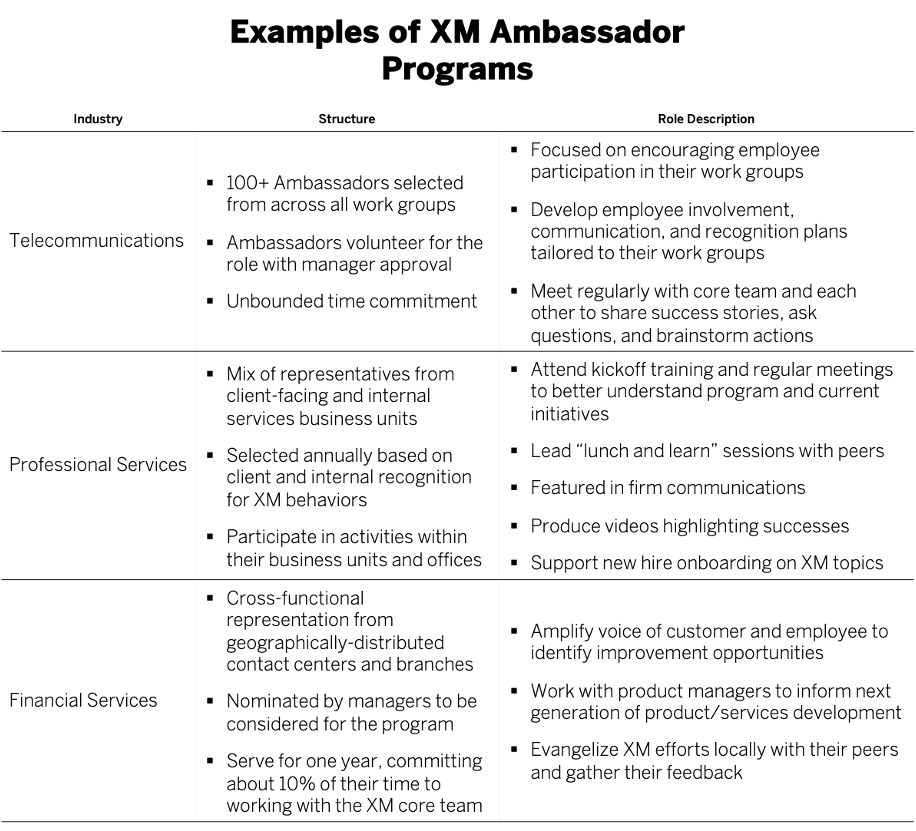We often work with organizations that want to drive large-scale change. To succeed, they need to blend top-down leadership with bottoms-up engagement. One of the tools that can enlist the required level of grassroots support is a strong Ambassadors (or Champions) Program. This type of program enlists employees from across the company in a well-defined, yet part-time role in supporting overall XM efforts.
These internal networks of advocates help forge a stronger connection between their teams and peers and the organization’s XM strategy and vision. XM ambassadors can serve as resources on project teams, as sources of employee feedback, and as communicators bringing XM messages to their peers.
Part change agent and part evangelist, XM ambassadors stretch the reach of XM Core teams across all levels of the organization. This group of motivated employees offers many benefits, including:
- A diverse set of voices amplifying XM messages in local, department, and enterprise-wide XM communications and training
- More people modeling and encouraging desired XM behaviors in relatable ways to their peers and colleagues
- An easily accessible group of employees to provide input and feedback on new ideas and planned XM initiatives
- Eyes and ears across the organization surfacing and sharing XM success stories and best practices
- A platform for celebrating success and building enthusiasm for XM across the organization
Building a Successful XM Ambassadors Program
Through our research and work with organizations, we’ve seen a variety of Ambassador Programs in action.

While there are many varieties of XM Ambassadors Programs, successful efforts typically focus on these five elements:
- Clearly define the Ambassador role. In order to attract the right talent and establish clear expectations for the individual and their manager, the XM core team needs to clearly lay out how Ambassadors will be asked to help. This includes participation expectations and time commitments (usually 10% to 20% of their time), along with a tangible set of characteristics that ideal Ambassadors will exhibit – such as a passion for XM, a desire to learn and drive change, and a set of skills that align with where the core team plans to have the Ambassadors contribute the most. The role description should be converted into measurable and repeatable identification and selection criteria that funnel into program applications or manager nomination forms that underpin the process to choose Ambassadors.
- Establish governance and accountability. Programs like these don’t run themselves, so the XM core team should only commit to starting an Ambassador program when it is ready and able to manage it. The core team should have a plan that outlines ongoing communications, collaboration sessions, recognition tactics, and the initiatives Ambassadors will be asked to participate in. The program’s governance model should provide the structure needed for the core team to hold Ambassadors accountable for their commitments. And when Ambassadors fulfill their commitments, they should be recognized both formally and informally.
- Prepare Ambassadors to be successful. Because Ambassadors are an extension of the XM core team, they need a strong understanding of the XM vision and strategy and what XM success looks like for the organization. For that reason, the XM Core Team needs to carefully design the onboarding process. This critical initial step should include a kick-off event where Ambassadors meet each other and learn the in’s and out’s of the role, complemented by training on the fundamentals of the organization’s XM program. Since one of the benefits of serving as an Ambassador should include a chance to develop new capabilities, the core team should look for ways to nurture relevant XM skills (like design thinking or interpreting XM insights) and to expose them to essential XM tools (like journey maps or maturity models). Lastly, the XM core team member who manages the program should be available via office hours or “on-demand” to provide 1:1 coaching to Ambassadors or help connect them with specialized assistance (such as data analysis) as they take independent actions to fulfill their role commitments.
- Tap into Ambassadors’ interests and abilities. Although Ambassador Programs are built around a common role defined by the XM core team, it’s important to leverage the unique capabilities of each Ambassador. When designing the role, the XM core team should recognize that “one size doesn’t fit all” and provide options and alternatives in how Ambassadors can support the goals of the program. For example, not all Ambassadors may be natural public speakers, so rather than requiring each one to deliver local “lunch and learn” training sessions, let those less comfortable in one-to-many settings put their time towards soliciting ideas or gathering input on new initiatives from their peers in groups of two or three. Or if an Ambassador has a hobby as a podcaster or graphic artist and is interested in bringing that to this role, be open to exploring ways to channel that interest into a beneficial contribution to the current program roadmap.
- Create an alumni network. Ambassadors usually serve for a specific period of time, typically a one or two-year term, before leaving their role to open up a spot for someone new to join the program. Because off-boarding is as important a part of the experience as onboarding, ambassadors who have completed their service should have a way to give formal feedback about their time in the program and be recognized for their collective contributions during their term. And it shouldn’t end there. XM core teams should keep connected to its previous Ambassadors by nurturing an alumni network. This can include a dedicated communication workstream to keep Ambassador alumni informed about XM program developments, opportunities for alumni to periodically contribute input or participate in a special project on an ad hoc basis, or getting alumni involved in selecting and onboarding new Ambassadors to their role.
Bottom line: Plug into the power of XM ambassadors to propel your XM program.



